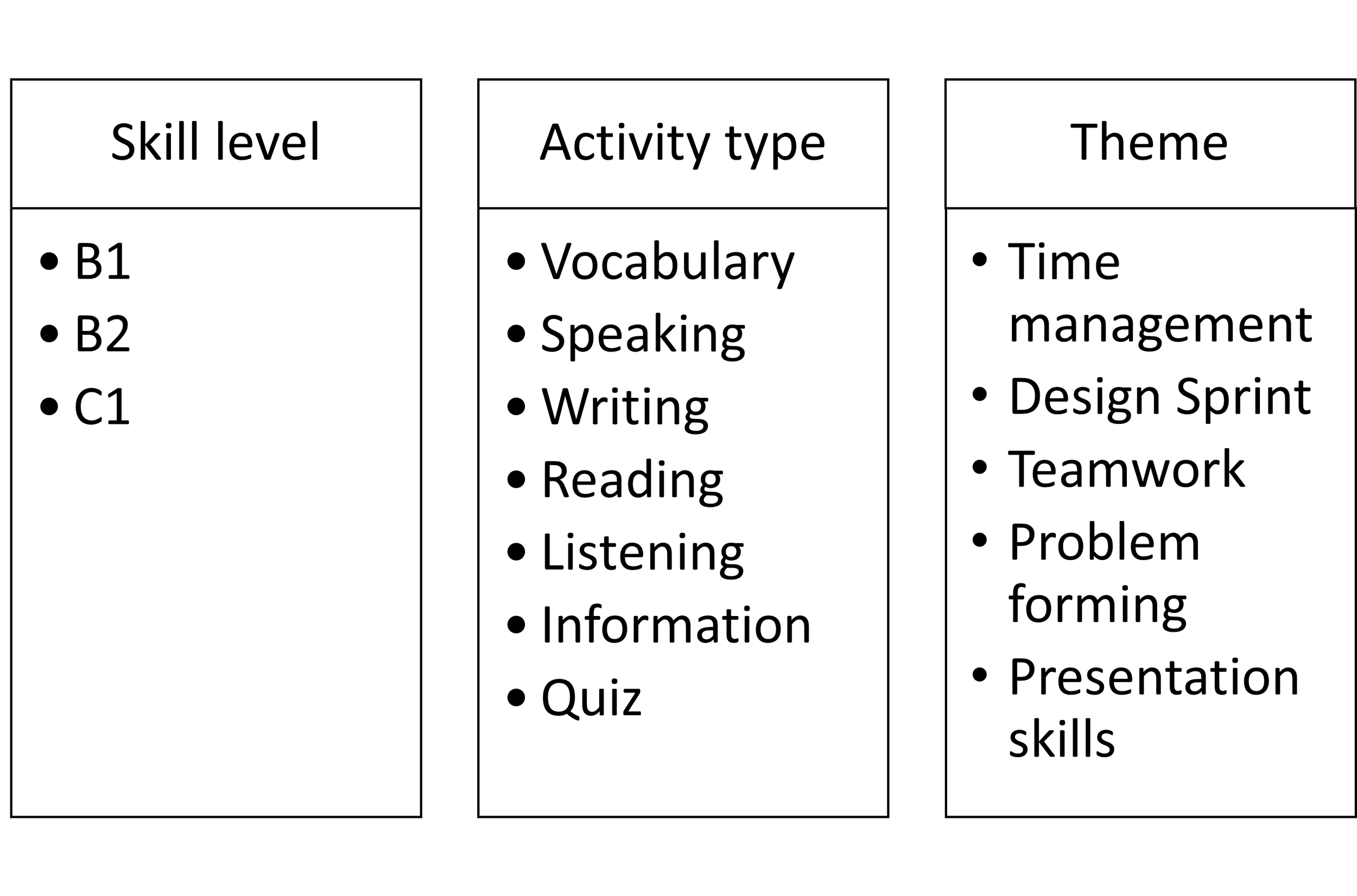Module activities
Below you can view all activities in the following thematic categories:
Click on the activities to view details and access attachments.
Each activity contains tags including the skill level the activity is aimed for, the activity type and the theme of the activity.
Activity types are also indicated with the following symbols:
You can also search the activities by skill level, activity type and theme. The search will open a new page.


Vocabulary

Speaking

Writing

Reading

Listening

Information

Quiz
Time Management
In this section, you will find a selection of tasks designed to help you plan the work you will put into the team project.
These activities help you to
understand how to plan and use your time while working with a team on a project,
use the appropriate vocabulary when creating a schedule and referring to time.
In this task, you will watch a video with some tips on managing time effectively during meetings. In part II, you will work on matching phrases to make sentences which were used in the video.
Listen to a video of Francis Wade who gives advice on time management.
Then put the tips given by Francis Wade in the above video in the correct order.
In this video, you will find a conversation about time management. Listen to the video to find some advice on time management . Next, click on the link below to open an activity with different time management tips and decide which ideas were mentioned in the conversation and which were not.
In this quiz, your task is to match the terms with their definitions.
Design Sprint Training
In this section you will find material to guide you and your team through a design sprint process.
The design sprint includes five phases, during which you will identify and formulate a challenge for your team, ideate different solutions, validate the solution, create a prototype and a finally present your idea in a form of a (video) pitch.
The phases are: 1. Mapping, 2. Defining, 3. Ideating, 4. Validating, and 5. Prototyping.
Once you have completed the design sprint, you will be able to:
apply entrepreneurial skills and mindset to recognise opportunities and co-create solutions;
understand and apply the basics of design thinking;
identify needs and challenges that need to be met;
work and co-operate with others to develop ideas and turn them into a prototype;
work efficiently as part of a self-directed team;
explore and experiment with innovative approaches;
believe in your ability to influence the course of events;
The entrepreneurial skills applied in the course have been defined with the help of the European Union Entrepreneurship Competence Framework: https://ec.europa.eu/jrc/en/publication/eur-scientific-and-technical-research-reports/entrecomp-entrepreneurship-competence-framework
Watch the video about the prototyping and steps and instructions for this phase.
Watch the video about the basics of pitching. Gather tips and useful advice to use in your own team's pitch.
Reflect individually: What typical elements of a sales pitch did you notice in Rener Gracie's pitch? What rhetorical or stylistic device did you notice him using while pitching? (Rhetorical device=a technique a speaker uses to engage the listener and to evoke emotional responses, with the goal of strengthening their argument and convincing the listener about the speaker's message).
In this short video, you will listen to Agnieszka giving advice on communication across culture based on her own experience. As you listen, fill in the gaps in the activity below.
Watch the video to explore the language used for indicating agreement and disagreement with team members.
After you have watched the video, create two short dialogues.
In this handout, you will find many examples of different phrases that you can use to make suggestions along with structures that follow these phrases and an activity to practise their use.
In this handout, you will find many examples of different phrases that you can use to respond to team members' suggestions both in situations when you agree or disagree with their ideas.
You will also practice the phrases to remember them better.
You will watch a video about Design Influences on design: Culture. Then you will have a listening comprehension activity and a speaking activity about differences in cultures and their impact on the different types of buildings.
In this handout, you will learn what an understatement is. You will also find a lot of useful phrases that can help you express your arguments in a gentle way.
On reading the handout you will be encouraged to look at our modern world from a little broader perspective. Additionally, the listening task will explain what an overview effect is and how it can prove useful and eye- opening.
This handout will give some basic information about the concept of VUCA and the following exercises will provide various adjectives to describe the modern world.
In these activities, you will have to recognise some international dishes and you will deal with two examples of international recipes. You will also have some practice with a word formation referring to countries.
In these activities, you will be using key vocabulary related to traffic.
You will also have to ask questions about traffic regulations in other countries and swap information on getting around your hometowns.
These activities will show you that certain gestures remain universal regardless of culture or language. But you will also see that different messages can be conveyed by the same gestures.
In the first task, you will come across some examples of greeting rituals. Remember their names as you will need to use them in the second task.
Covid -19 is no joking matter, but a few coronavirus and quarantine jokes can brighten your day. You will find them in the activity: Pun on words -Covid 19.
You may need to use a dictionary for the idiomatic expressions you will encounter in "Expressions for undergoing hardship" task.
We are all experiencing the COVID-19 pandemic in different ways. We are also eyewitness to world-changing events developing in real-time. Axel, a computer science student at Poznan University of Technology is talking about his experience with the pandemic. Listen to the interview, and think of additional questions you would like to ask students from other countries. In mixed groups with students from other countries, prepare interviews and record them.
Play this scavenger hunt about pandemics and related topics.
In this activity, some situations are presented to raise your awareness about cultural differences around the world.
Check what skills you have in social communication. Choose an appropriate response in a variety of social situations provided.
In this task, you will find some information about origins of different loanwords that entered English. You will also be able to learn some new vocabulary as well as explore the topic of loanwords further and quiz each other about various loanwords with your peers using the link below.
Technical problems may always happen. In this video, you will hear some phrases that you need to know when you want to inform others about some technical issues during an online meeting. In the handout above, you will find a list of different sentences that may be useful then.
This handout will give you information about personality traits (OCEAN) and will help you create a profile about yourself. You can use this profile to introduce yourself to your team members, and also to guide yourself in professional life, and to understand others' behaviour and actions.
Reading and understanding the OCEAN traits will also give you useful vocabulary.
This handout explains that one team member should take turns to keep the minutes of team meetings and outlines the type of information that needs to be included.
In addition, the handout provides examples of the type of language that is used in writing up meetings.
Teamwork in Transnational Teams
In this section you will find activities designed to prepare you for working in a team of students from various countries.
Once you have completed the tasks, you will be able to:
communicate effectively in a project carried out by transnational teams;
use appropriate phrases
make suggestions while discussing the project in groups;
agree or disagree with your group peers
use appropriate language while working in transnational teams (vocabulary , style and register development tasks).
comment on your peers' ideas
cooperate in transnational teams while respecting cultural differences
Formulating a problem
This section provides activities which will help you to narrow down and specify a problem in such a way that you can start solving it.
When you have completed the activities in this section, you will be able to:
identify and express a manageable problem
formulate a problem statement that will allow you to start tackling the problem and creating a solution.
describe products
describe a process (sequence connectors and passive voice)
Read this handout to learn about how to specify a problem and create a problem statement.
Watch the video to examine the difficulties of defining a manageable problem and explore some examples of how problems can be defined and narrowed down, so that solutions can be found.
Try this quiz to check your ability to identify and formulate a solvable problem. You'll also explore which elements need to be included in order to be able to tackle the problem.
In this quiz, you will consider how to formulate a problem statement:
Engineers use their scientific knowledge to develop solutions to problems in order to do it the go through a design process. Watch the clip Engineering Design Process and answer the questions.
There are five aspects that have to be born in mind in order to describe an object: appearance, use, dimensions, materials and properties. Read and complete the exercises you will find in the following document that includes information about the ways to describe an object.
In this document you will find information and exercises about sequence connectors and passive voice, two language aspects which are crucial for describing processes.
Presentation skills
In this section, you will explore what is involved in giving an effective presentation.
When you have completed the activities in this section, you will be able to:
explain the content and characteristics of a good pitch
plan a well-structured presentation, using effective signposting to guide the listeners
demonstrate the use of strategies to engage your audience
pronounce the keywords accurately
create and deliver a successful pitch of an idea, product or service.
Read this handout to explore some strategies for engaging those listening to your pitch and keeping them interested throughout the presentation.
In this video, you will learn what a FAB analysis is. By using FAB, you can position your idea, product or service so that the listeners understand the value that it brings to them. This is especially important when you are pitching a new product.
Have you understood the concept of a FAB analysis? Try this quiz to check that you understand the difference between features, advantages and benefits that a product or service can bring to users.
Read this handout to discover some tips for making sure you can confidently pronounce the most important terms you will need to use when you give a pitch or presentation.
When you are ready to practise your pitch or presentation, try these activities to work on pronunciation and the use of your voice.
Introduction and structure of a presentation.
In this handout, you will find a lot of useful phrases that will guide the audience through your presentation.
This listening activity presents some advice on how to use voice and your intonation to engage your audience in your presentation.
In this activity you can practise the use of collocations that were used in the recording in a previous task.
In this activity, you need to complete the presentation with some singposting phrases. In addition, the text of the presentation gives you a few tips on how to prepare your presentation and what can help you control your nerves during your presentation. Once you have finished the task, you can listen to the presentation to check your answers.
Read this handout to find out more about the purpose of a pitch and the elements it typically contains.
In these activities, you are going to practise different verbs along with the preposition you can use in your presentation.
These activities allow students to practice the use of different verbs along with the prepositions that may be useful when you make a presentation. There is also a speaking practice - giving a mini-presentation.
Giving exact percentages when describing a graph can be substituted by less accurate phrases.
In the link provided below, you will have some practice with using less accurate expressions for data when describing graphs.
In this handout, you will have some practice with synonyms for words and expressions used to describe trends presented in graphs. You will also deal with different ways of presenting data.
Experts say that the first few minutes of a presentation are the most important. In this handout, you'll have to match the provided items to make attention-grabbing openings. You will also have to recognize the names of the techniques used in the openings.






























































